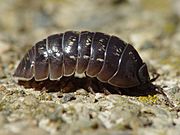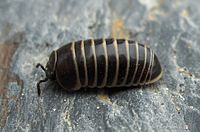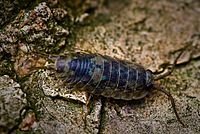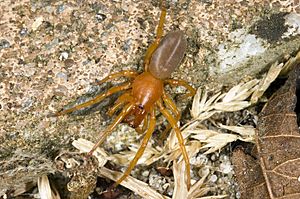Woodlouse facts for kids
Quick facts for kids Woodlice |
|
|---|---|
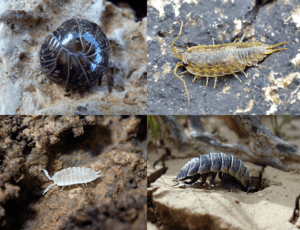 |
|
| Clockwise from top right: Ligia oceanica, Hemilepistus reaumuri, Platyarthrus hoffmannseggii and Schizidium tiberianum | |
| Scientific classification | |
| Sections | |
|
A woodlouse is a small creature with a hard outer shell. It belongs to a group called crustaceans, just like crabs and lobsters. Woodlice are part of a special group called Oniscidea.
Long ago, the first woodlice lived in the ocean. Over time, they slowly moved onto land. This happened about 300 million years ago, during a period called the Carboniferous time. Even though most woodlice now live on land, some still live near water or have even gone back to living in water.
Woodlice have a body made of different parts, like segments. They have seven pairs of legs. Female woodlice carry their eggs in a special pouch under their body. This pouch is called a marsupium. It helps keep the baby woodlice safe and gives them water and food. When they hatch, the young woodlice are called mancae. They grow by shedding their outer skin many times.
Scientists have found many different kinds of woodlice. There are over 3,700 known species around the world. They live in many different places, from wet forests to dry deserts and high mountains. Woodlice are very good at adapting to different environments.
People often keep woodlice as terrarium pets. They are easy to care for and come in many interesting colors and shapes.
Contents
What are Woodlice?
Woodlice are small invertebrates. This means they do not have a backbone. They are part of the crustacean family. This family also includes animals like crabs, lobsters, and shrimp. Woodlice are special because they are one of the few crustaceans that live mostly on land.
They have a hard outer shell, like armor. This shell protects them. Woodlice are often found in damp, dark places. You might see them under rocks, logs, or leaves. They like these places because they need moisture to breathe and to keep their bodies from drying out.
Common Names for Woodlice
Woodlice have many different names around the world. These names often describe how they look or act. Some names talk about how they can roll into a ball. Other names compare them to a pig.
Here are some common names:
- "armadillo bug"
- "pill bug" (This name is often used for woodlice that can roll into a ball.)
- "roly-poly"
- "sow bug"
- "slater" (This name is common in Scotland, New Zealand, and Australia.)
- "potato bug"
- "cheeselog"
- "chiggy pig"
- "doodlebug"
How Do Woodlice Grow? (Life Cycle)
Woodlice have a hard outer shell called an exoskeleton. As they grow, this shell becomes too small. So, they have to shed it. This process is called molting.
Woodlice molt in a special way. They shed the back half of their shell first. Then, two or three days later, they shed the front half. This is different from most other insects and crustaceans. They usually shed their whole shell at once.
After mating, a female woodlouse carries her fertilized eggs in a special pouch. This pouch is called a marsupium. It is on the underside of her body. The eggs stay there until they hatch. When the babies hatch, they look like tiny, white woodlice. They are often curled up in little balls. The mother then "gives birth" to her young. Some female woodlice can even have babies without a male. This is called asexual reproduction.
Pill Bugs and Pill Millipedes
Some woodlice, like the common pill bug, can roll up into a tight ball. This is a defense mechanism. It helps them protect themselves from predators.
Pill bugs can sometimes be confused with pill millipedes. Both are small, segmented creatures. They live in similar places and can both roll into a ball. This is an example of convergent evolution. It means two different types of animals developed similar features because they live in similar environments.
However, there are ways to tell them apart:
- Legs: Pill millipedes have two pairs of legs on most body segments. Woodlice (isopods) have only one pair of legs per segment.
- Segments: Pill millipedes have 12 to 13 body segments. Woodlice have 11 segments.
- Appearance: Pill millipedes often look smoother. They also look more like other millipedes in their color and segment shape.
Where Do Woodlice Live? (Ecology)
Woodlice breathe using special lungs. These lungs are on their paddle-shaped back legs. They are called pleopodal lungs. Woodlice need moisture to survive. They lose water quickly through their skin and when they get rid of waste. This is why you usually find them in damp, dark places.
Most woodlice are active at night. They are detritivores. This means they eat dead plant matter, like decaying leaves. They help break down dead plants and recycle nutrients in the soil.
While most woodlice live on land, some have returned to living in water. For example, the sea slater (Ligia oceanica) lives near the ocean. Other species live in freshwater or even underground lakes.
Woodlice are a food source for many animals. Spiders, like the woodlouse spider (Dysdera crocata), often eat them. Some land worms also prey on woodlice.
Are Woodlice Pests?
Woodlice are usually helpful in gardens. They help control other pests and break down dead plants. This helps make the soil healthier.
However, sometimes woodlice can eat cultivated plants. They might nibble on ripening strawberries or young seedlings.
Woodlice can also come into homes. They usually do this when they are looking for moisture. If you see many woodlice in your house, it might mean there is a dampness problem. But woodlice are not considered a serious household pest. They do not spread diseases. They also do not damage wood or structures that are in good condition.
Woodlice in the British Isles
There are over 45 different kinds of woodlice in the British Isles. They come in many colors and sizes. They can be from 3 to 30 millimeters long.
Five species are very common:
- Oniscus asellus (the common shiny woodlouse)
- Porcellio scaber (the common rough woodlouse)
- Philoscia muscorum (the common striped woodlouse)
- Trichoniscus pusillus (the common pygmy woodlouse)
- Armadillidium vulgare (the common pill bug)
Images for kids
See also
 In Spanish: Oniscidea para niños
In Spanish: Oniscidea para niños



